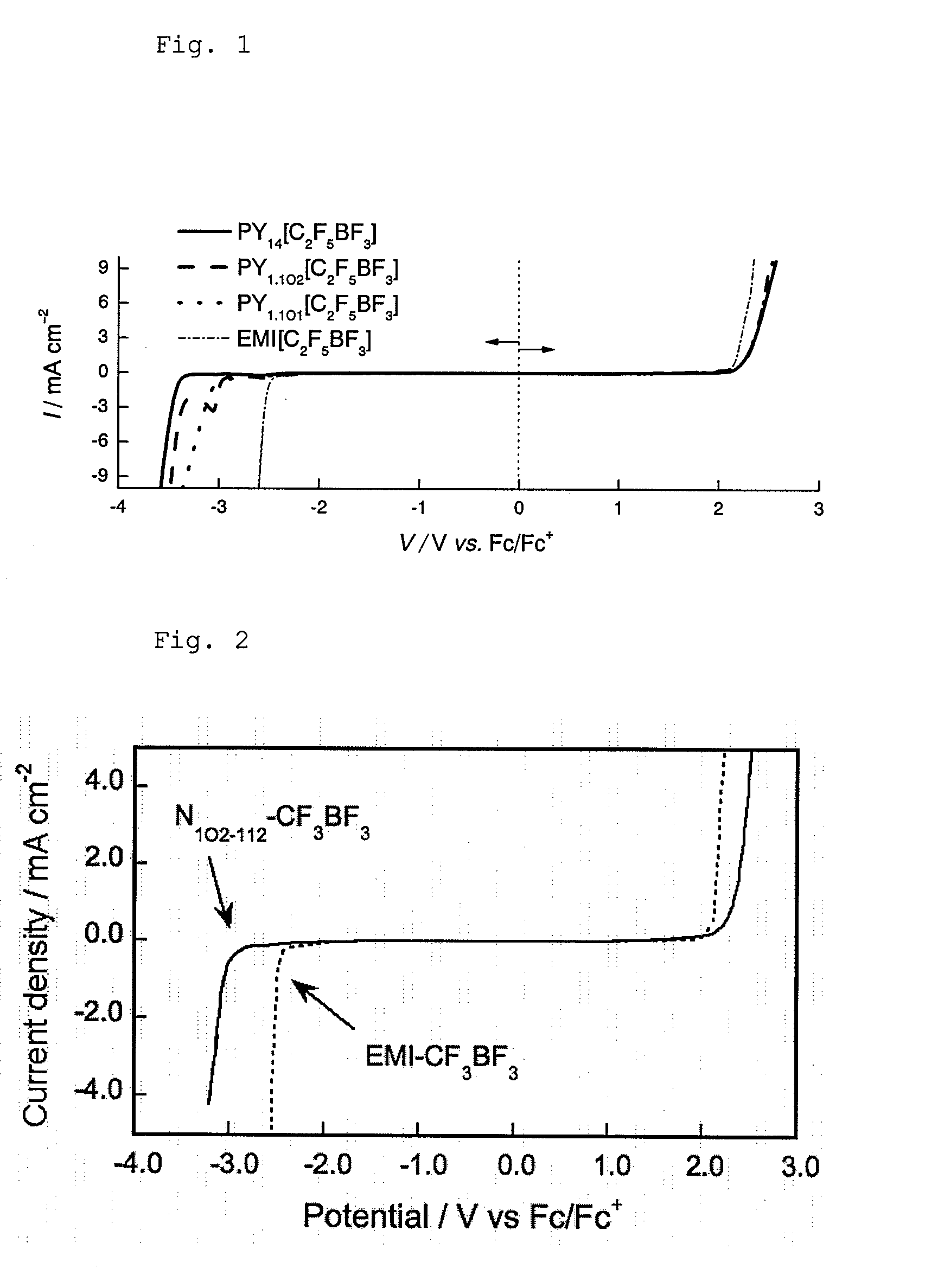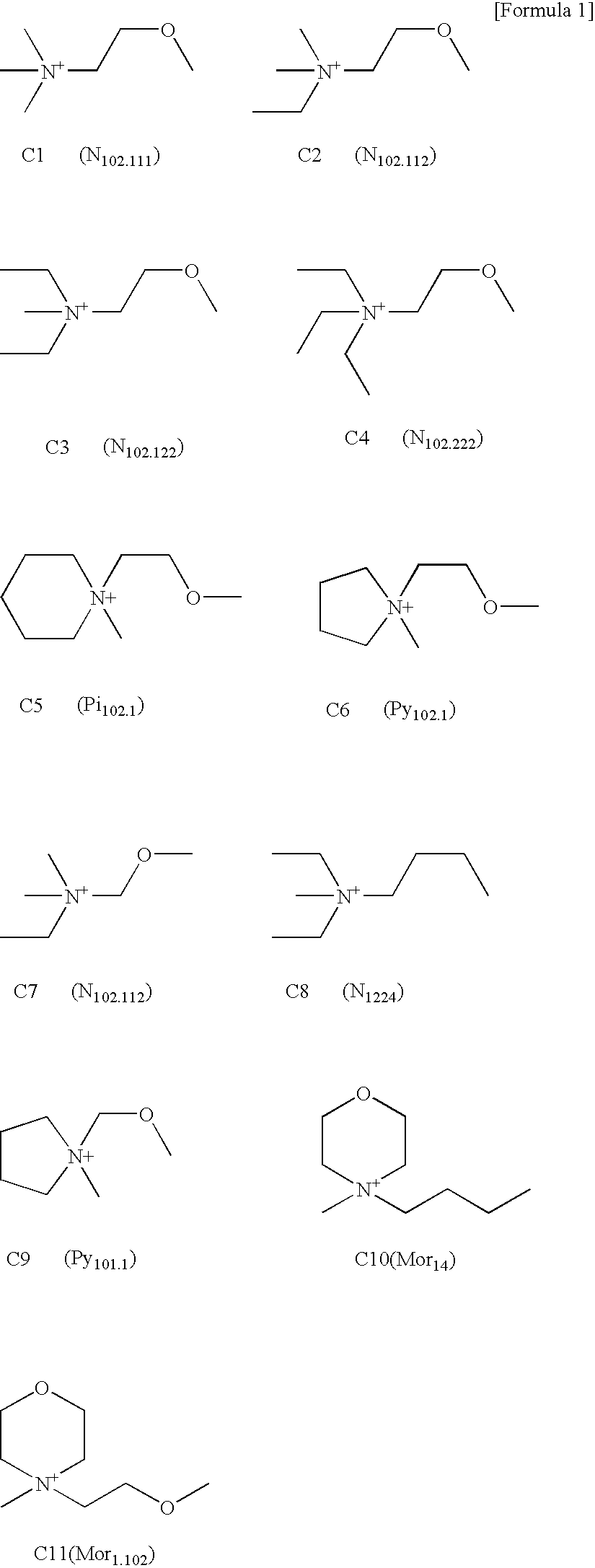Ionic liquid, method for producing same, double layer capacitor comprising same, and lithium battery
a technology of ionic liquid and double layer capacitor, which is applied in the direction of non-aqueous electrolyte cells, group 3/13 element organic compounds, electrochemical generators, etc., can solve the problems of low conductivity, inability to serve as ionic liquid, and suffer from ionic liquids containing these anions. , to achieve the effect of low viscosity and melting poin
- Summary
- Abstract
- Description
- Claims
- Application Information
AI Technical Summary
Benefits of technology
Problems solved by technology
Method used
Image
Examples
reference example 1
Anion Synthesis
[0062] K[CF3BF3] was prepared in the manner as described in G. A. Molander, B. J. Hoag, Organometallics, 22, (2003), 3313, and then the K[CF3BF3] was subjected to a cation exchange process as described in S. Mori, K. Ida, and M. Ue, U.S. Pat. No. 4,892,944 (1990), thereby yielding aqueous Hsolv.[CF3BF3]solv.
[0063] K[C2F5BF3], K[n-C3F7BF3] and K[n-C4F9BF3] were prepared in the manner as described in Zhi-Bin Zhou, Masayuki Takeda, Makoto Ue, J. Fluorine. Chem, 123 (2003) 127, and then the K[C2F5BF3], K[n-C3F7BF3] and K[n-C4F9BF3] were each subjected to a cation exchange process as described in S. Mori, K. Ida, and M. Ue, U.S. Pat. No. 4,892,944. (1990), thereby yielding aqueous solv[n-C2F5BF3]solv, Hsolv[n-C3F7BF3]solv and Hsolv[n-C4F9BF3]solv, respectively
reference example 2
Cation Synthesis
[0064] (1) Synthesis of diethylmethylmethoxyethylammonium chloride (C3: N102122+Cl−)
[0065] An amine (diethylmethylamine) and an equimolar amount of a halogen-substituted ether compound (methoxyethylchloride) as starting materials were mixed in acetonitrile, and then the mixture was reacted for 12 to 72 hours by heating in an autoclave under mild conditions. After the reaction, the quaternary ammonium salt product was recrystallized in an appropriate solvent, and the formation of diethylmethylmethoxyethylammonium chloride (N102122+Cl−) was confirmed by NMR.
[0066] The halide thus obtained was converted to the hydroxide (N102122+OH−) with an anion exchange resin.
[0067] (2) Synthesis of trimethylmethoxyethylammonium bromide (C1: N102111+Br−); dimethylethylmethoxyethylammonium bromide (C2: N102112+Br−); and triethylmethoxyethylammonium bromide (C4: N102222+Br−)
[0068] CH3OCH2CH2Br and an equimolar amount of an amine (one each of triethylamine, dimethylethylamine or tr...
example 1
Preparation of Ionic Liquids
[0079] An aqueous solution (50 mmol) of any one of the anions (Hsolv.[CF3BF3]solv, Hsolv[n-C2F5BF3]solv, Hsolv[n-C3F7BF3]solv and Hsolv[n-C4F9BF3]solv) obtained in Reference Example 1 was filtered before use, and then the filtrate was neutralized by an equimolar amount of any one of the hydroxides of ammonium cations obtained in Reference Example 2. The ionic liquid was concentrated to about 20 ml under reduced pressure at 30 to 40° C., and then the bottom layer was separated, followed by washing with deionized water (10 ml) and toluene (20 ml×2). The resulting ionic liquid bottom layer was dried under vacuum (0.03 mmHg) at 60° C. for 12 hours, so as to yield the target ionic liquid.
[0080] Tables 3 to 5 below show the combinations of the anions and cations along with their physical values.
[0081] In addition, data such as NMR (1H, 11B and 19F), elemental analysis and the like on some of the ionic liquids obtained are presented below:
N102.122[BF4]
[0082]1...
PUM
| Property | Measurement | Unit |
|---|---|---|
| melting point | aaaaa | aaaaa |
| melting points | aaaaa | aaaaa |
| melting points | aaaaa | aaaaa |
Abstract
Description
Claims
Application Information
 Login to View More
Login to View More - R&D
- Intellectual Property
- Life Sciences
- Materials
- Tech Scout
- Unparalleled Data Quality
- Higher Quality Content
- 60% Fewer Hallucinations
Browse by: Latest US Patents, China's latest patents, Technical Efficacy Thesaurus, Application Domain, Technology Topic, Popular Technical Reports.
© 2025 PatSnap. All rights reserved.Legal|Privacy policy|Modern Slavery Act Transparency Statement|Sitemap|About US| Contact US: help@patsnap.com



